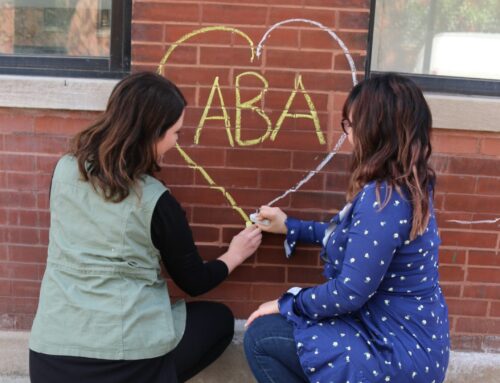A quick reference guide for parents in understanding behavior challenges.
It’s an all-too-familiar scene. Your child has come home from therapy or school and it’s time to clean up their toys from this morning, but they’d rather play a game on the iPad. Or, you’re at the store and they run toward the toy aisle, even though you’ve already said, “no toys on this trip!” We fill with dread, knowing the reaction to come, and say, “NO.” So it begins: screaming, running away, flopping on the ground, or even hitting. NOW, WHAT?
Challenging behaviors are faced by every parent, no matter the child’s ability, level of functioning, or diagnosis. It’s generally a fact of parenting. But there are ways we can consistently manage, and even prevent, many of these behaviors. But first, we need to understand: what are behaviors? This blog will help you better understand and manage challenging behaviors that you may face with your child.

Behavior 101: Understanding Behavior
Behaviors are anything that can be observed (seen, felt, heard), measured, and defined. For example, let’s look at screaming.
Can we observe it? Oh, yes.
Can we measure it? Yes! We can measure behaviors in two ways: frequency, which is: how often (as in how many times per minute, hour, days, weeks, months). Duration, which is: How long? (not just how long it feels!) Seconds, minutes, hours?
Can we define it: Yes! Screaming: an often high-pitched, forceful vocalization.
Understanding common motivation behind behaviors:
Most behaviors serve one of the four following functions. Some behaviors can even be a combination of these categories:
Attention: child is engaging in behavior to get your attention.
Escape: child is engaging in behavior to get away from something they don’t want to do.
Tangible: child is engaging in behavior to get something they want/because they didn’t get what they wanted.
Sensory: child is engaging in behavior for sensory needs (maybe it’s too loud) or because they seem to enjoy behavior (occurs even if no one is around).
Behavior Modification: how do we address the behavior?
Behaviors are complex and often have many functions, as we see above. Some of these behaviors may also involve communication breakdowns and struggles.
Extensive behavior modification — especially for frequent, severe, and or/dangerous behaviors — requires behavior modification through a Behavior Intervention Plan, developed with a Board Certified Behavior Analyst (BCBA). Blue Bird’s team of BCBA’s are all experts in challenging behaviors! Talk to your child’s team to see about qualifications for Applied Behavior Analysis (ABA) services and behavior therapy at Blue Bird Day.
Once we understand function of behavior, your child’s BCBA will help you record data on these behaviors so that we understand the ABC’s: Antecedents (what happens BEFORE the behavior). Behavior: what is the behavior. Consequences: What do we do in response to the behavior? Your child’s BCBA will also record data, complete questionnaires about behavior function, and observe your child to develop a Behavior Intervention Plan, which will be implemented both at therapy by your child’s team and in-home.
We wish we had a “cheat sheet” for quick-fixing behavior struggles, but no single approach will be a perfect cookie cutter solution for every child. But, a better understanding of behavior overall will help us make smarter, more efficient decisions as parents that will help our child grow and overcome many common behavior challenges and struggles.

Stick to the plan: the three “c’s” of behavior modification:
Once you have a behavior plan in place, the best thing we can do is follow that plan! This is important even for addressing behaviors on your own before consulting with behavior therapists, or for more minor behaviors. Always remember the three c’s of challenging behaviors: calm, consistent, control.
Calm: remain calm. You got this! Your child can sense changes in emotion (especially if they are attention seeking). Do your best to keep a “poker face” at all times, and show your child are not having an emotional reaction (especially if they are attention seeking!!!). Take deep breaths and even turn away or step back a moment.
Consistent: the key to reducing challenging behaviors is to have a consistent response. SAME RESPONSE, EVERY PERSON, EVERY BEHAVIOR, EVERY TIME! It’s okay if we forget in a moment of stress. Just re-visit your plan and stick to it. The worst thing we can do is sabotage ourselves by sometimes giving in and buying the toy, sometimes not. By doing this we teach our child that their behavior might sometimes work, so they will always keep trying it. Stick with your consistent response, and YOU WILL SEE RESULTS!
Control: Remember: YOU ARE IN CONTROL. It may not seem this way, especially when we first address challenging behaviors, and depending on the severity of these behaviors. But remember, you are the adult. You have control of rewards given, activities planned, sources of comfort and attention. You have the choice to give these things and when to give them. Though it may feel “out of control’ during a behavior, you ultimately hold all the cards.
Remember, your Blue Bird Team is here to help! Please reach out to your child’s team when facing consistent behavior challenges at home. We are here for you!

Blue Bird Day fosters socialization, sensory regulation, and pre-academic learning in children ages 2-7 years in therapeutic rotations that simulate preschool and kindergarten settings. Our compassionate therapists practice a relationship-based and family-centered approach, provide parent training, and collaborate on goals and individualized intensive treatment plans for your child.
We believe in a collaborative and multi-disciplinary team approach to therapy. A team of occupational therapists, speech-language pathologists, dietitians, developmental therapists, behavioral therapists, physical therapists, and therapeutic assistants are created for each child to ensure child and family are fully supported and the best possible results are achieved.
Options for individualized, group and virtual therapy sessions are available as well.
Want to learn more or you have a specific question? Feel free to connect with us here!



